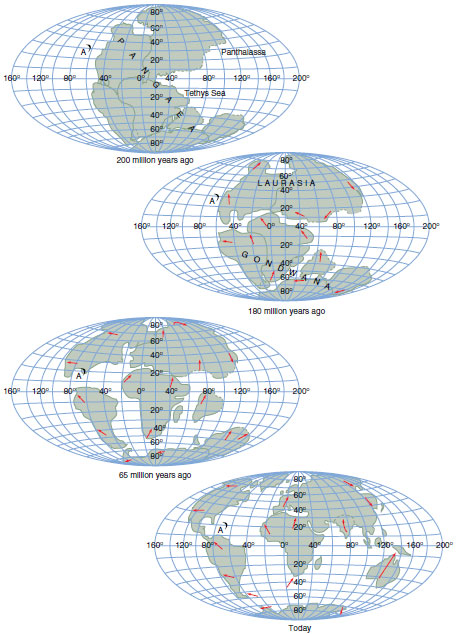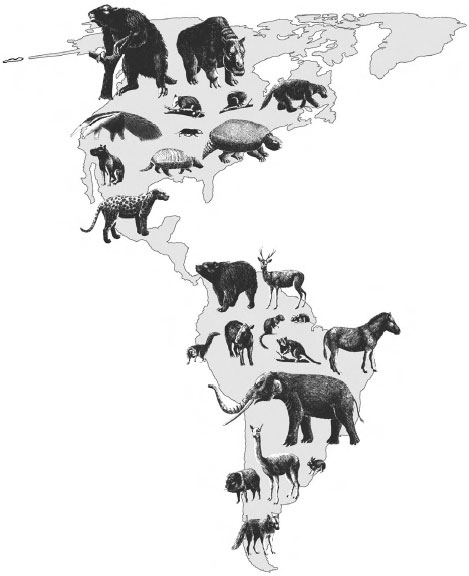Continental Drift Theory
Continental Drift Theory
It is no accident that the current enthusiasm for vicariance biogeography coincides with the recent acceptance of the continental drift theory by geologists. The continental drift theory is not new (it was proposed in 1912 by the German meteorologist Alfred Wegener), but it remained controversial and largely neglected until the newly proposed theory of plate tectonics provided a mechanism to account for drifting continents (unfortunately, Wegener did not live to see his hypothesis accepted). According to the theory of plate tectonics (tectonics means “deforming movement”), the earth’s surface is composed of 6 to 10 rocky plates, about 100 km thick, that shift about on a more malleable underlying layer. Wegener proposed that the earth’s continents had been drifting like rafts following the breakup of a single great landmass called Pangaea (“all land”). According to recent workers who have considerably revised Wegener’s dating, the original breakup of Pangaea occurred approximately 200 million years ago. Two great supercontinents were formed: a northern Laurasia and a southern Gondwana, separated from each other by the Tethys Sea (Figure 39-15). At the end of the Jurassic period, some 135 million years ago, the supercontinents began to fragment and drift apart. Laurasia split into North America, most of Eurasia, and Greenland. Gondwana split into South America, Africa, Madagascar, Arabia, India, Southeast Asia, Australia, and Antarctica. This theory is supported by the appearance of fit between the continents, by airborne paleomagnetic surveys, by seismographic studies, by the presence of mid-ocean ridges where the tectonic plates are born, and by a wealth of biological data.
Continental drift explains several otherwise puzzling distributions of animals, such as the similarity of invertebrate fossils in Africa and South America, as well as certain similarities in present-day faunas at the same latitudes on the two continents. However, the continents have been separated for all of the Cenozoic era and probably for much of the Mesozoic era as well,much too long to explain the distributions of some modern organisms such as placental mammals. Continental drift theory is, nevertheless, enormously useful in explaining interconnections between flora and fauna of the past.
The present distribution of marsupial mammals is an excellent example of the influence of continental breakup. Marsupials appeared in the Middle Cretaceous period, about 100 million years BP, probably in South America. Because South America was at that time connected to Australia through Antarctica (which was then much warmer than it is today), the marsupials spread through all three continents. They also moved into North America, but there they encountered placental mammals, which had dispersed to that continent from Asia. Marsupials evidently could not coexist with placentals, and so became extinct in North America. (North American marsupials today, the opossums, are relatively recent arrivals from South America.) Placentals followed marsupials into South America, but by that time the marsupials had expanded and were too firmly established to be driven into extinction. In the meantime, about 50 million years BP, Australia drifted apart from Antarctica, barring entrance to placentals. Australia remained in isolation, allowing marsupials to diversify into the present rich and varied fauna.
Temporary land bridges also have been important pathways of dispersal. An important and well-established land bridge that no longer exists connected Asia and North America across the Bering Strait. It was across this corridor that the placentals moved from Asia into North America.
Today a land bridge connects North and South America at the Isthmus of Panama. But from the mid- Eocene epoch (50 million years BP) to the end of the Pliocene epoch (3 million years BP), the two continents were completely separated by water. During this long period, the major groups of mammals evolved in distinctive directions on each continent. When the land bridge was reestablished at the end of the Pliocene epoch, a tide of mammals began to flow in both directions (Figure 39-16). This dispersal has been called the “Great American Interchange,” one of the most important minglings of distinct continental faunas in the earth’s history. For a period both continents gained in mammalian diversity, but the extinction of large numbers of mammals on both continents soon followed. North American carnivores such as raccoons, weasels, foxes, dogs, cats (including sabercats), and bears began preying on South American mammals, which previously had evolved in an environment free of carnivores. Other North American invaders included hoofed mammals (horses, tapirs, peccaries, llamas, deer, antelopes, and mastodonts), rabbits, and several families of rodents. These mammals displaced many South American residents occupying similar habitats. Today nearly half of South American mammals are descendants of recent North American invaders. Only a few South American invaders survived in North America: porcupines, armadillos, and opossums. Several other South American groups, including giant ground sloths, glyptodonts, anteaters, giant aquatic capybaras, toxodonts (rhino-sized plant eaters), and giant armadillos, entered North America but subsequently became extinct there.
It is no accident that the current enthusiasm for vicariance biogeography coincides with the recent acceptance of the continental drift theory by geologists. The continental drift theory is not new (it was proposed in 1912 by the German meteorologist Alfred Wegener), but it remained controversial and largely neglected until the newly proposed theory of plate tectonics provided a mechanism to account for drifting continents (unfortunately, Wegener did not live to see his hypothesis accepted). According to the theory of plate tectonics (tectonics means “deforming movement”), the earth’s surface is composed of 6 to 10 rocky plates, about 100 km thick, that shift about on a more malleable underlying layer. Wegener proposed that the earth’s continents had been drifting like rafts following the breakup of a single great landmass called Pangaea (“all land”). According to recent workers who have considerably revised Wegener’s dating, the original breakup of Pangaea occurred approximately 200 million years ago. Two great supercontinents were formed: a northern Laurasia and a southern Gondwana, separated from each other by the Tethys Sea (Figure 39-15). At the end of the Jurassic period, some 135 million years ago, the supercontinents began to fragment and drift apart. Laurasia split into North America, most of Eurasia, and Greenland. Gondwana split into South America, Africa, Madagascar, Arabia, India, Southeast Asia, Australia, and Antarctica. This theory is supported by the appearance of fit between the continents, by airborne paleomagnetic surveys, by seismographic studies, by the presence of mid-ocean ridges where the tectonic plates are born, and by a wealth of biological data.
 |
| Figure 39-15 Hypothesized drift of continents over the past 200 million years from an original single landmass to their present positions. The universal landmass Pangaea first separated into two supercontinents (Laurasia and Gondwana). These later separated into smaller continents. The arrows indicate vector movements of the continents. The black crescent labeled A is a modern geographical reference point representing the Antilles arc in the West Indies. |
Continental drift explains several otherwise puzzling distributions of animals, such as the similarity of invertebrate fossils in Africa and South America, as well as certain similarities in present-day faunas at the same latitudes on the two continents. However, the continents have been separated for all of the Cenozoic era and probably for much of the Mesozoic era as well,much too long to explain the distributions of some modern organisms such as placental mammals. Continental drift theory is, nevertheless, enormously useful in explaining interconnections between flora and fauna of the past.
The present distribution of marsupial mammals is an excellent example of the influence of continental breakup. Marsupials appeared in the Middle Cretaceous period, about 100 million years BP, probably in South America. Because South America was at that time connected to Australia through Antarctica (which was then much warmer than it is today), the marsupials spread through all three continents. They also moved into North America, but there they encountered placental mammals, which had dispersed to that continent from Asia. Marsupials evidently could not coexist with placentals, and so became extinct in North America. (North American marsupials today, the opossums, are relatively recent arrivals from South America.) Placentals followed marsupials into South America, but by that time the marsupials had expanded and were too firmly established to be driven into extinction. In the meantime, about 50 million years BP, Australia drifted apart from Antarctica, barring entrance to placentals. Australia remained in isolation, allowing marsupials to diversify into the present rich and varied fauna.
Temporary land bridges also have been important pathways of dispersal. An important and well-established land bridge that no longer exists connected Asia and North America across the Bering Strait. It was across this corridor that the placentals moved from Asia into North America.
Today a land bridge connects North and South America at the Isthmus of Panama. But from the mid- Eocene epoch (50 million years BP) to the end of the Pliocene epoch (3 million years BP), the two continents were completely separated by water. During this long period, the major groups of mammals evolved in distinctive directions on each continent. When the land bridge was reestablished at the end of the Pliocene epoch, a tide of mammals began to flow in both directions (Figure 39-16). This dispersal has been called the “Great American Interchange,” one of the most important minglings of distinct continental faunas in the earth’s history. For a period both continents gained in mammalian diversity, but the extinction of large numbers of mammals on both continents soon followed. North American carnivores such as raccoons, weasels, foxes, dogs, cats (including sabercats), and bears began preying on South American mammals, which previously had evolved in an environment free of carnivores. Other North American invaders included hoofed mammals (horses, tapirs, peccaries, llamas, deer, antelopes, and mastodonts), rabbits, and several families of rodents. These mammals displaced many South American residents occupying similar habitats. Today nearly half of South American mammals are descendants of recent North American invaders. Only a few South American invaders survived in North America: porcupines, armadillos, and opossums. Several other South American groups, including giant ground sloths, glyptodonts, anteaters, giant aquatic capybaras, toxodonts (rhino-sized plant eaters), and giant armadillos, entered North America but subsequently became extinct there.
 |
| Figure 39-16 The Great American Interchange. The Isthmus of Panama emerged approximately 3 million years ago, permitting the extensive interchange of many families of mammals. At top are representatives of 38 South American genera that walked north across the isthmus. At bottom are representatives of 47 North American genera that migrated to South America. The North American immigrants diversified rapidly after entering South America. South American immigrants to North America diversified little and most became extinct. |




